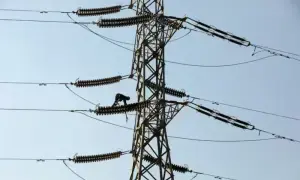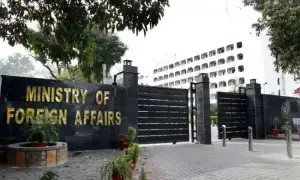HYDERABAD: Chashma-Jhelum (CJ) link canal has also been opened by Punjab government after opening of Taunsa-Panjnad (TP) link canal while Sindh was experiencing 37 per cent shortage at its barrages on April 27.
A discharge of 1,708 cusecs was reported in CJ link canal on April 26 for the purpose of Greater Thal Canal (GTC) that has an allocation under Water Accord 1991. Its flow was increased to 2,000 cusecs in the next 24 hours by April 28.
But Sindh’s objection, according to Sindh’s member in Indus River System Authority (Irsa) Mohammad Ehsan Leghari, is that at the pretext of the GTC these flows were actually withdrawn for CJ link canal. “Sindh has a 30pc water shortage at its barrages,” he said.
He added that flows in the GTC could only be released once water requirements of Sindh’s barrages were already met and Jhelum-Chenab (J-C) zone doesn’t have flows. Currently, he said, J-C zone has plenty of water flows, yet flows from Indus river were being diverted.
Paucity has already taken a toll on cotton crop cultivation in Kharif season
The CJ link canal feeds GTC Phase-I (launched and completed in the Gen Pervez Musharraf regime despite Sindh Assembly’s resolutions then).
Now its Phase-II has been planned by the Punjab government and this phase II is part of six strategic canals that have become a point of interprovincial discord, sparking Sindh-wide agitations for the last over 10 days. Violence was reported on Sunday in different parts of the province as the sit-in by lawyers continued for the 10th day at Babarloi, Khairpur.
CJ link canal, according to the Sindh irrigation department, which has a designed discharge capacity of 21,700 cusecs, transfers water from Indus river at Chashma barrage, located Taunsa upstream, to Jhelum-Chenab (J-C) zone which was objected to by Sindh usually.
Sindh also receives its indented supplies for its three barrages from Irsa at Chashma barrage amidst objections that such indented supplies should be made available at Guddu barrage to avoid travel losses. Similarly, TP link canal also diverts water from Indus to J-C zone upstream Panjnad barrage.
Jhelum river at Mangla was having an inflow of 42,186 cusecs on April 27 with an outflow of 32,000 cusecs. The dam’s level stood at 1130.30ft against its maximum storage of 1242.0ft. Tarbela recorded an inflow of 39,400 cusecs against outflow of 46,700 cusecs on the same day with a level of 1430.87ft against its maximum storage of 1550.0ft.
However, discharges from the dam indicate it was facing depletion to meet downstream water requirements including those of link canals. It was only on April 20 and 21 when the dam had an inflow of 50,000 plus cusecs for two days and Irsa increased some flows for the provinces.
But its flows have dropped again or a little over 40,000 plus cusecs in the last several days. “We note that 2,000 cusecs are released for CJ link canal for sowing purposes and these flows will increase in the days to come, therefore more flows for CJ’s can’t be ruled out. It is that’s why outflows from Tarbela are being increased as was indicative from April 27’s discharges,” he added.
Sindh was experiencing 37pc shortage at its barrages with Sukkur barrage showing 34pc and Kotri barrage 30pc shortage. Guddu barrage’s canals were not withdrawing water on account of annual closure. However, from May onward all canals of Guddu barrage and right side canals of Sukkur barrage would also be needing water for rice sowing, thus necessitating demand for more water flows.
“Kotri barrage is now bound to bear major brunt of water shortage [50pc shortage in May] as it is supposed to receive 12,000 cusecs in the first 10 days of May whereas currently its upstream discharge remains below 6,000 cusecs. Out of it, hardly a flow of 190 cusecs is released downstream Kotri mainly for drinking purposes of Hyderabad city and its vicinity,” said the official
The shortage has affected Kharif season’s main cotton crop cultivation significantly this year. A sowing of 19pc was reported until April 24 against 44pc cultivation in the corresponding period last year in Sindh. The cash crop is grown on the left bank of Indus river where shortage remained unending since March when its sowing usually begins.
Earlier, TP link canal was opened on April 15 with a discharge of 2,981 cusecs that has now been substantially increased.
Sindh Irrigation Minister wrote two letters over opening of TP link canal, questioning discharges in the canal and the Punjab irrigation department also accused Sindh of underreporting discharge data.
After examining two sides’ correspondences Irsa spokesman had insisted that Irsa was taking all decisions (regarding water distribution) in accordance with Water Apportionment Accord 1991. Irsa spokesman was not available for comment on opening of CJ link canal when contacted Sunday evening.
Published in Dawn, April 28th, 2025


































